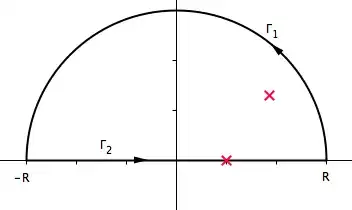Sorry for not using contour integrals but why not simply calculate the integral on the real axis and apply the definition of Cauchy's principal value (https://en.wikipedia.org/wiki/Cauchy_principal_value) as the symmetric limit about the point $z=1$?
Here we go
Let $0<\epsilon<<1$ and decompose the integral $i$ into two parts $i_1$ and $i_2$ excluding the point $z=1$:
$$i_1(\epsilon) = \int_{-\infty}^{1-\epsilon}\frac{1}{(z-\alpha)^2(z-1)}\,dz $$
$$i_2(\epsilon) = \int_{1+\epsilon}^{\infty}\frac{1}{(z-\alpha)^2(z-1)}\,dz $$
Then with
$$i(\epsilon) = i_1(\epsilon)+i_2(\epsilon)$$
the principal value of the integral is given by
$$i = P.V.\int_{-\infty}^{\infty}\frac{1}{(z-\alpha)^2(z-1)}\,dz =\lim_{\epsilon \to 0} \, i(\epsilon )$$
For $\Im(a)>0$ he integrals are elementary with the results
$$i_1=\frac{(\alpha +\epsilon -1) \log (\epsilon )-(\alpha +\epsilon -1) \log (\alpha +\epsilon -1)+\alpha -1}{(\alpha -1)^2 (\alpha +\epsilon -1)}$$
$$i_2=\frac{(-\alpha +\epsilon +1) \log (\epsilon )+(\alpha -\epsilon -1) \log (-\alpha +\epsilon +1)-\alpha +1}{(\alpha -1)^2 (\alpha -\epsilon -1)}$$
so that we get, after some simplifications
$$i = \lim_{\epsilon \to 0} \, i(\epsilon ) = \frac{\log (1-\alpha)-\log (-1+\alpha )}{(\alpha -1)^2}$$
But now
$$\log(-1+\alpha) = \log((-1)(1-\alpha)) = \log(-1) +\log(1-\alpha)$$
so that
$$i=\frac{-\log(-1)}{(\alpha-1)^2}=\frac{- i \pi}{(\alpha-1)^2}\tag{*}$$
For a check I have let Mathematica calculate the original integral with PrincipalValue->True and found $(*)$.
Discussion
- It was already mentioned (by Daniel Fisher) that we obtain the same result when we split the pole on the real axis into two poles with half the residue each, one shifted by an amount $\epsilon>0$ above and the other one by an amount $\epsilon$ below the real axis. As there are now no poles on the real axis we can complete the contour on the real axis and obtain
$$\int_{-\infty }^{\infty } \frac{\frac{1}{2 (z-i \epsilon -1)}+\frac{1}{2 (z+i \epsilon -1)}}{(z-\alpha)^2} \, dz \\= \int_{-\infty }^{\infty } \frac{z-1}{(z-1)^2+\epsilon^2}\frac{1}{(z-\alpha)^2} \, dz\\=\frac{-i \pi }{(\alpha+i \epsilon -1)^2}\text{sign}(\Im(\alpha))\to \frac{-i \pi }{(\alpha -1)^2}\text{sign}(\Im(\alpha))$$
which generalizes $(*)$ to $\Im(\alpha)<0$.
- If we would take an asymmetric limit, say $i= \lim_{\epsilon \to 0} \, (i_1(\epsilon )+i_2(\gamma\epsilon))$ we would obtain
$$i_{asym}= -\frac{\log (\gamma )+i \pi }{(\alpha -1)^2}$$
we also obtain a finite result but this depends on an arbitrary parameter $\gamma$.
